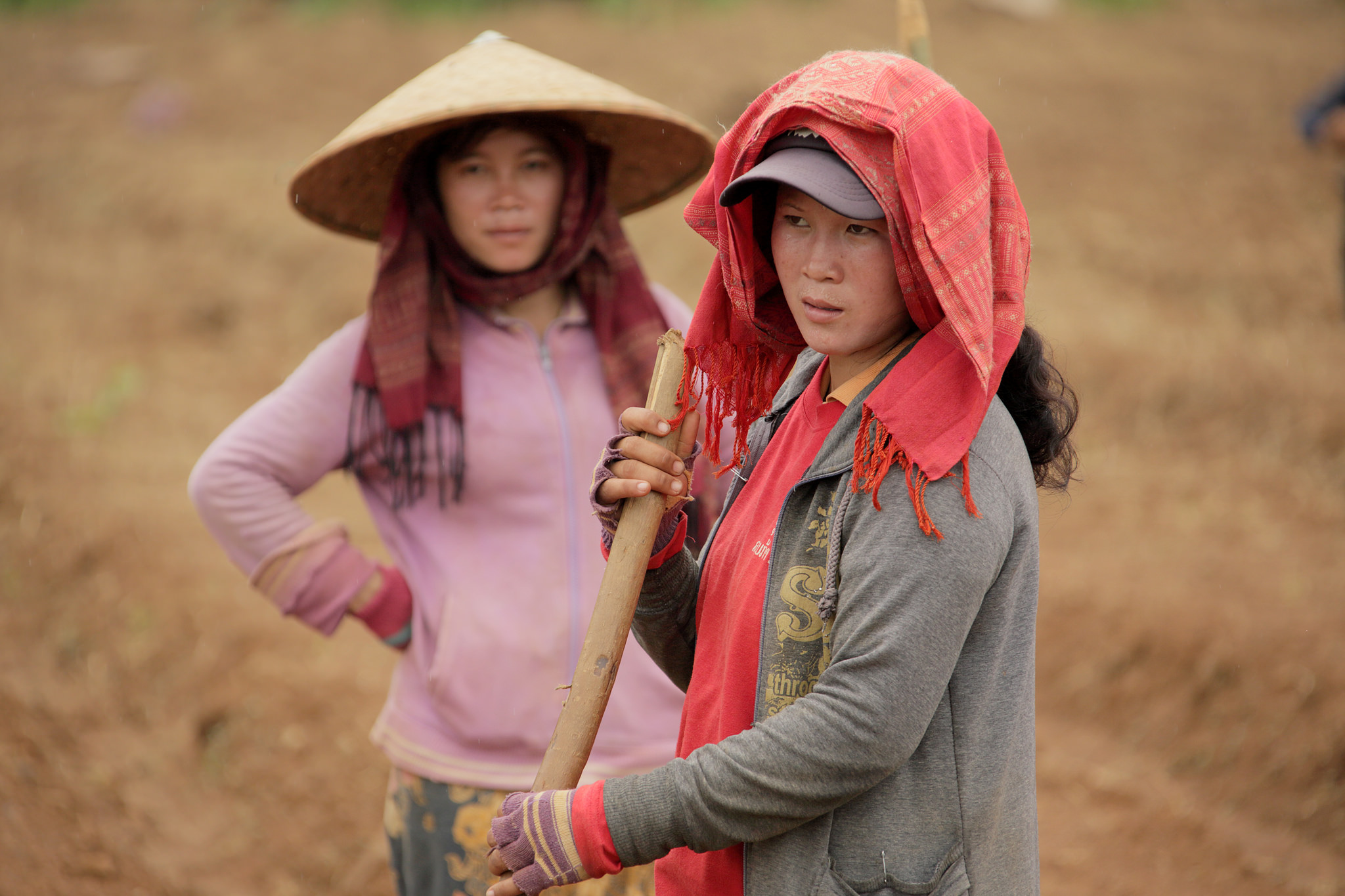Map of land concessions & leases (Schönweger et al 2012, p. 24)
[1] IndexMundi, Population density. http://www.indexmundi.com/facts/indicators/EN.POP.DNST/rankings.
[2] World Bank, “World Development Indicators: Rural environment and land use”. http://wdi.worldbank.org/table/3.1.
[3] Vientiane Times, “Forest cover goal possible if managed properly”, 22 July 2014, https://wle-mekong.cgiar.org/forest-cover-goal-possible-if-managed-prope... Vongdeuane Vongsiharath, “Forest cover and land-use changes in Lao PDR according to the National Forest Reconnaissance Survey” (no date), http://www.fao.org/3/a-l1067e/l1067e01.pdf
[4] Hirsch P and Scurrah N, “The Political Economy of Land Governance in Lao PDR” (Vientiane: Mekong Region Land Governance Project, 2015), p. 2.
[5] Evrard O and Goudineau Y, “Planned Resettlement, Unexpected Migrations and Cultural Trauma in Laos,” Development and Change 35:5 (2004): 937-962.
[6] Baird I and Shoemaker B, “Unsettling Experiences: Internal Resettlement and International Aid Agencies in Laos,” Development and Change 38:5 (2007): 865-888.
[7] Akhom Tounalom (Vice Minister of the Ministry of Natural Resources and Environment), Preface to Schönweger O, Heinimann A, Epprecht M, Lu J, and Thalongsengchanh P, Concessions and Leases in the Lao PDR: Taking Stock of Land Investments (Bern and Vientiane: Centre for Development and Environment (CDE), University of Bern, and Geographica Bernensia, 2012), p. 6.
[8] World Bank, Lao PDR Development Report 2010 – Technical Note: The socio-geography of mining and hydro in Lao PDR: Analysis Combining GIS Information with Socioeconomic Data (Washington: The World Bank, 2011), p.1.
[9] Hirsch and Scurrah, “Political Economy”, p. 15.
[10] Heinimann A, Schönweger O, Epprecht M, Nanhthavong V, and Hett C. “On the Right Path?
Land Concessions in Laos”, CDE Policy Brief, No. 3 (Bern, Switzerland: Center for Development and Environment, 2014).
[11] Constitution of the Lao People’s Democratic Republic (2015), Article 3.
[12] Ibid., Article 17.
[13] Land Law (No. 04/NA, 2003), Article 3.
[14] Ibid., Articles 16, 20.
[15] Hirsch and Scurrah, “Political Economy”, p. 5.
[16] Wells-Dang A, Nyi Soe K, Inthakoun L, Tola P, Socheat P, Nguyen TTV, Chabada A, and Youttananukorn W, “A Political Economy of Environmental Impact Assessment in the Mekong Region,” Water Alternatives 9:1 (2016): 39, 43.
[17] Law on Investment Promotion (No. 02/NA, 2009), Articles 21-23.
[18] Vientiane Times, “Draft land policy has ‘no problems,’ lawmaker says”, 25 April 2015. http://www.laolandissues.org/2015/04/25/draft-land-policy-has-no-problem....
[19] Land Law, Articles 43-49.
[20] Ibid., Article 53.
[21] Ibid., Articles 18, 22.
[22] Vaenkeo S, “Ministry reaffirms plan to issue 400,000 land titles by 2020”, Vientiane Times, 15 October 2015, http://www.vientianetimes.org.la/FreeContent/FreeConten_Ministry_reaffir... Vientiane Times, “Govt set to issue 60,000 land titles next fiscal year”, 17 September 2015, http://www.laolandissues.org/2015/09/17/govt-set-to-issue-60000-land-tit....
[23] Sengdara S, “Complaints of excessive fees in land title issuance”, Vientiane Times, 23 October 2015. http://www.vientianetimes.org.la/FreeContent/FreeConten_Complaints.htm.
[24] Vaenkeo S, “Coordinated action needed to address overlapping land titles,” Vientiane Times, 21 October 2015. http://www.vientianetimes.org.la/FreeContent/FreeConten_Coordinated%20ac....
[25] Forestry Law (No. 6/2007), Articles 39, 42.
[26] Hirsch and Scurrah, “Political Economy”, p. 11.
[27] Seidel K, Phanvilay K, Vorachit B, Mua S, Boupphachan S, and Oberndorf R, Study on Communal Land Registration in Lao PDR, Land Policy Study No. 6 (Vientiane: GTZ, 2007), vii. http://www.mekonginfo.org/assets/midocs/0002525-environment-study-on-com....
[28] See a literature review in Dwyer M, “Turning Land into Capital: A review of recent research on land concessions for investment in Lao PDR” (Vientiane: Land Issues Working Group, 2007). The inventory was conducted by the Center for Development and Environment (CDE) and is housed in part at the Lao DECIDE web portal (www.decide.la).
[29] UXO Lao, “UXO Impact”, http://www.uxolao.org/index.php/en/the-uxo-problem/uxo-impact.
[30] Land Law, Articles 7, 14.
[31] Ibid., Articles 63, 68 and 71; Decree 192/PM on the Compensation and Resettlement of the Development Project, issued 7 July 2005, http://prflaos.org/policy/pm-decree-1922005-compensation-and-resettlemen....
[32] Phouthonesy E, “Time to review land policy: NA members”, 2010. http://www.laoembassy.com/21.6.10%20Time%20to%20review%20land%20policy.pdf.
[33] Wellmann D, “The Legal Framework of State Land Leases and Concessions in the Lao PDR”, discussion paper, Integrated Rural Development in Poverty Regions of Laos (IRDP) under the Northern Upland Development Programme (NUDP), 2012, p. 3.
[34] Schönweger O, Heinimann A, Epprecht M, Lu J, and Thalongsengchanh P, Concessions and Leases in the Lao PDR: Taking Stock of Land Investments (Bern and Vientiane: Centre for Development and Environment (CDE), University of Bern, and Geographica Bernensia, 2012), pp. 20-21, 27.
[35] Ibid., p. 29.
[36] Ibid., p. 19.
[37] Land Law, Article 65.
[38] Wellmann, “Legal Framework”, p. 18.
[39] Dwyer, “Turning Land into Capital”, p. 7.
[40] Wellmann, “Legal Framework”, p. 4.
[41] Schönweger et al, Concessions and Leases, pp. 9, 24-25.
[42] Dubus A, “The true cost of Laos’ banana plantations”, Southeast Asia Globe (February 2016). http://sea-globe.com/laos-banana-plantations/.
[43] Heinimann et al, “On the Right Path?”; Schönweger et al, Concessions and Leases, p. 27.
[44] Dubus, “The true cost of Laos’ banana plantations”.
[45] Land Law, Articles 80-81.
[46] Land Law, Article 80; Decree 88/PM on Implementation of the Land Law.
[47] Decree 135/PM on State Land Lease or Concession; Wellmann, “Legal Framework”, p. 11.
[48] Kenney-Lazar M, “Plantation rubber, land grabbing and social-property transformation in southern Laos”, Journal of Peasant Studies 39:3-4 (2012), 1017-1037.
[49] McAllister, K, “Rubber, rights and resistance: the evolution of local struggles against a Chinese rubber concession in Northern Laos”, Journal of Peasant Studies 42:3-4 (2015), 817-837.
[50] Land Issues Working Group, “Cases from the field”. http://www.laolandissues.org/case-studies/.
[51] Khonesavanh Latsaphao. Vientiane Times, “Land owners notified of compensation for highway project,” 23 December 2015, http://vientianetimes.org.la/FreeContent/FreeConten_Land%20owners.htm; Hirsch and Scurrah, “Political Economy”, p. 4.
[52] Kepa, “Reflections on Lao Civil Society”, 2015. https://www.kepa.fi/tiedostot/reflection_paper_laos_2015_0.pdf.
[53] Hale E and Solum A, “Laos NGO restrictions threaten development, say non-profit groups”, South China Morning Post, 17 September 2014. http://www.scmp.com/news/asia/article/1594490/laos-ngo-restrictions-thre....
[54] Land Issues Working Group, “Who We Are”, http://www.laolandissues.org/about-us-2/who-we-are-2/.

